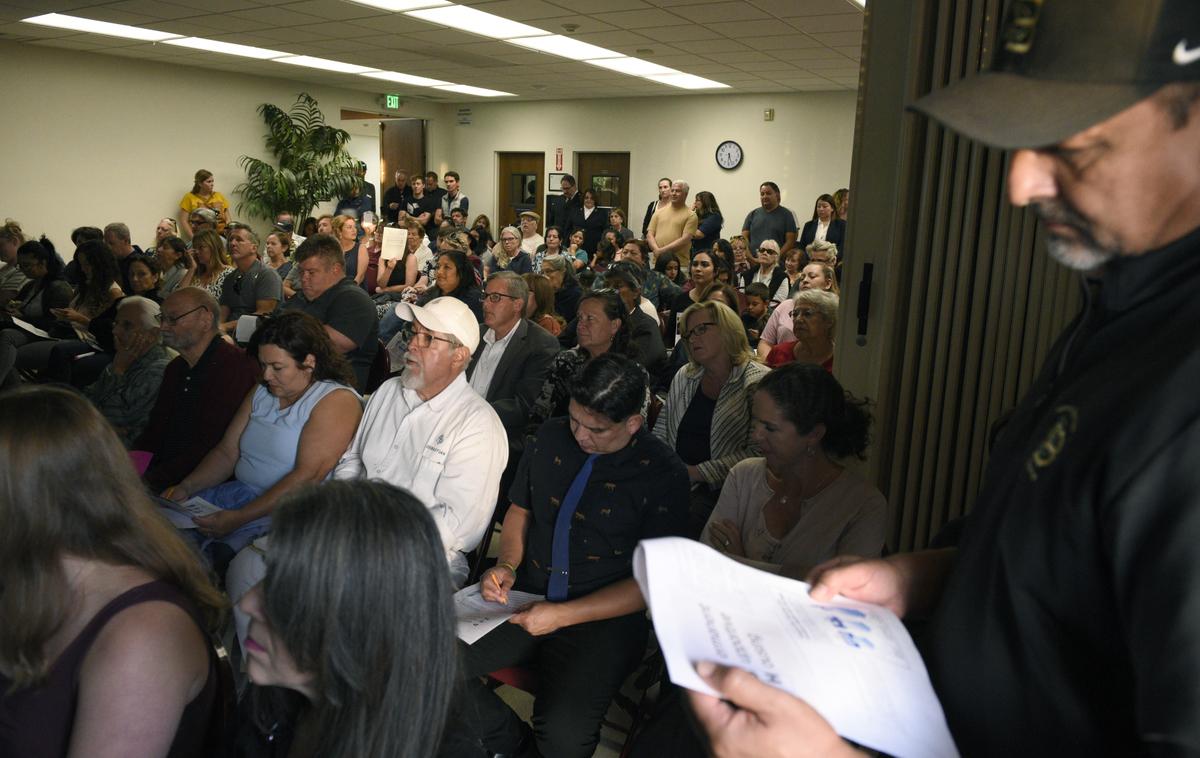Outraged Residents Contest Alisos Street Homeless Housing Project
Neighbors Argue Crime, Parking, Safety Concerns over Salvation Army Proposal

What was supposed to be Salvation Army’s community presentation on its plan for an Eastside homeless housing project quickly turned into a chaotic, angry mass of 150 neighbors determined to stop it at all costs.
“Every time the city wants to dump something, they dump it on the Eastside,” said area resident Natasha Todorovic. “This will be just like Casa Esperanza [now PATH]. They dumped it on us, and there is now a 500 percent increase in crime in the surrounding area.”
The proposed project is considered permanent supportive housing, meaning it is not a homeless shelter or transitional living program. The house, located at 15 South Alisos Street, would contain 10 bedrooms and house up to 14 single men or women — provided they have gone through recovery programs, passed background checks, and were selected through the Salvation Army’s coordinated entry system.
A social worker is assigned to visit the property “as needed” to assist the formerly homeless tenants with any issues. On-site staff will not be provided, however. No registered sex offenders would ever be allowed to rent because it is within a few blocks of three schools.
“This is not a homeless shelter. These people are like any other people renting an apartment in the community,” said Mark Gisler, executive director of the Salvation Army in Santa Barbara. “These tenants are not random people off the street. They are vetted, sign a lease with rules, and just like anyone else, they are subject to eviction if they break the lease.” He added that the average stay for permanent supportive housing tenants is five years.

The presentation did not quell the fury of the Eastside residents packed into the Franklin Neighborhood Center. Rather than holding public comment, the Salvation Army’s team asked attendees to write their questions on index cards so they could answer them during the second half of the presentation. With more than 100 questions, the process quickly spiraled out of control.
“Why do you get to cherry pick the questions?” a few people shouted.
Although Major Osei Stuart with the Salvation Army attempted to soothe the tension, more people began shouting questions, and representatives began answering them. That, in turn, sparked more audience members to follow suit. Nearly half the question-and-answer period darted off its intended course before Salvation Army representatives could reel it back in. They promised to answer residents’ dozens of unanswered question cards via email.
The audience remarks concerned safety, crime, and parking, among other matters. Salvation Army’s Media Manager Robert Brennan said parking wouldn’t be an issue because most renters won’t own a car. When it came to safety and crime, he said, it shouldn’t be too much of a worry because of the vetting process and regular social worker visits. “Why don’t we get your phone number so we can call you when there’s an issue!” one person shouted at Brennan from the back of the room.
“We strongly suggest you call the police if anything illegal is going on,” Brennan retorted. His comment garnered significant backlash from the crowd, which became angrier with each long-winded, evasive answer.
District 1 City Councilmember Jason Dominguez swooped in during the final minutes of the meeting and pacified his Eastside constituents with just one sentence: “At this point, I haven’t heard anyone here who has changed their minds,” he said. “My recommendation is that there needs to be some significant alterations to the plan to get this for the community. … There were many questions that weren’t answered here tonight.” Dominguez said everyone in the room would be given due process. The project is only in its beginning stages, he added, and is far from being a “done deal,” prompting sighs of relief through the room.

Although nearly everyone in attendance was against the project, a handful of supporters spoke. Sharon Byrne, former executive director of the Milpas Association and a member of the Salvation Army’s advisory board, spoke as part of the presentation. She said she lives directly behind the Salvation Army on the Westside and close to seven or eight supportive housing complexes similar to the proposed Alisos project. “I can tell you, I’ve had a problem with the guys panhandling near my yard,” she said. “But those guys weren’t residents of the Salvation Army.”
Emily Allen, director of Homeless and Veteran Programs at United Way Home for Good, was also in attendance. “This kind of reminds me of when Willbridge was developed on State near Peabody School and people flipped out,” Allen said. “Time has passed, and there hasn’t been a huge impact. … This kind of permanent housing really isn’t different than other kinds.”
The project will go before the city’s Architectural Board of Review on October 7.




You must be logged in to post a comment.